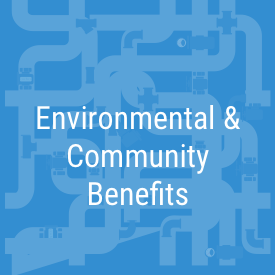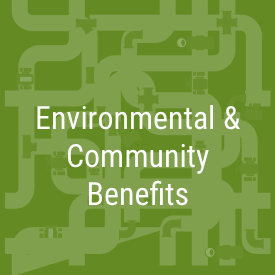Preferred project: A federal-state-local partnership
This project continues a partnership with the U.S. Army Corps of Engineers (USACE), to plan, design and construct improvements along 4.2 miles of Upper Penitencia Creek from the confluence with Coyote Creek to Dorel Drive. Part of the project will protect the area around the Bay Area Rapid Transit’s (BART) Berryessa station near King Road, which would otherwise be subject to flooding.
In addition to providing flood protection, this multi-objective project will provide ecological restoration and recreation benefits while preserving the water supply. The natural creek channel will be preserved while adjacent existing open space and parkland will remain as recreational areas, only rarely taking the role as a temporary floodplain so that floodwaters do not enter surrounding neighborhoods and commercial areas. Proposed construction measures may include modified floodplains, limited levees/ floodwalls, a bypass channel, and fish passage improvements.
Local-funding-only project
The original local-funding-only project was to acquire all necessary rights-of-way and construct a 1% (100-year event) flood protection project from Coyote Creek confluence to King Road, which would have protected 450 parcels. In December 2019, the Valley Water Board directed staff to use the available local funding to complete the design and construction of the locally funded project as well as build the reaches of the preferred project that can be constructed with the available funding. This approach extends the local-funding-only project from King Road to Capitol Avenue and provides 1% flood protection for an additional 800 parcels. As a result, the new local-funding-only project is to construct flood improvements along Upper Penitencia Creek from the confluence of Coyote Creek to Capitol Avenue to increase the 1% flood protection provided with local available dollars to 1,250 parcels, including the new Berryessa BART station.








See Environmental & Community Benefits section for complete description of Key Performance Indicators (KPIs).
The Design Phase for the local-funding-only project (KPI #2), began in summer 2023 and is expected to take approximately three years to complete. The Design Phase includes Phases I and II of the project, extending from Coyote Creek to Capitol Avenue. Phase III, Capitol Avenue to Dorel Road, is part of the project with federal and local funding (KPI #1).
There is currently no federal funding for this project. Therefore, Valley Water has focused on the local-funding-only project (KPI #2). In FY23, Valley Water conducted an additional review of the Planning Study Report (PSR) and finalized the revised PSR in December 2022.
The PSR discusses the current creek conditions, defines objectives, analyzes alternatives based on the project's alternative ranking methodology, describes public input, and identifies the staff-recommended alternative, including its operation and maintenance and potential mitigation requirements. During the Planning Phase, the staff-recommended alternative was developed in coordination with the City of San José, Santa Clara County, Eastside Union High School District, property owners, resource agencies, stakeholders, and the public. The PSR and additional project documents are available in the Reports & Documents section of this webpage.
On January 24, 2023, the Valley Water Board of Directors approved modifying the project’s funding allocation to remove the project’s construction-related planned allocations, thus impacting the construction of the project. The reduction in funding allocation became effective on July 1, 2023 (FY24). The modification was necessitated due to construction cost escalations across the Safe, Clean Water Program impacting the program’s financial health. The project’s construction-related dollars were reallocated to the Safe, Clean Water Program’s Operating and Capital Reserves to help fund the Coyote Creek Flood Protection Project (E1) construction. While the Design and Permitting phase funding is secured, Valley Water will reassess construction funding availability annually as part of the Capital Improvement Program’s (CIP’s) financial planning process.
August 2024
Planning Study Report (PSR) and Supporting Appendices
- Upper Penitencia Creek Flood Protection Project Final PSR
- Appendix A: Landscape Vision Report
- Appendices B through I: Conceptual Alternatives
Inundation Maps
SFEI Vision Report
Public Meeting Materials
May 15, 2019:
Staff provided an update on the feasible alternatives which reflected the public input received at the October 2018 public meeting.
October 2, 2018:
FY22-36 Key Performance Indicator for the Safe, Clean Water Program
-
Preferred project with federal and local funding: Construct a flood protection project to provide 1% (100-year) flood protection to 8,000 parcels.
-
With local funding only: Construct a 1% (100-year) flood protection project from Coyote Creek confluence to Capitol Avenue to provide 1% (100-year) flood protection to 1,250 parcels, including the new Berryessa BART station.
Benefits
-
Preferred project provides up to 1% flood protection to approximately 8,000 homes, schools and businesses
-
Local-funding-only project provides 1% flood protection to 1,250 parcels, including the new Berryessa BART station
-
Restores/enhances ecological and riparian habitat
-
Reduces sedimentation and maintenance requirements
-
Improves water quality in Upper Penitencia and Coyote creeks
-
Provides opportunities for recreation improvements consistent with the City of San José and Santa Clara County Park master plans
-
Addresses climate change as the project is designed to increase flow capacity, thereby reducing flood risks from storm events projected to become more frequent and intense due to climate change. Furthermore, the project accounts for 2 feet of sea level rise
Geographic Area of Benefit
San José
Flooding History
With the capacity to carry less than a 10-year event, Upper Penitencia Creek has had a history of flooding since Valley Water began preparing flood reports in 1967. Damaging flood events occurred in 1978, 1980, 1982, 1983, 1986, 1995, and 1998- impacting many homes, businesses, and surface streets. In 2017, the creek caused minor flooding when it overflowed its banks near Independence High School in San José. In 2023, stormwater from Penitencia Creek overflowed its creek banks and flooded the San Jose Flea Market and Penitencia Creek County Park, leaving debris and mud.
Potential damages from a 1% (or 100-year) flood event are estimated at $455 million (in 2004 dollars, according to a USACE economic analysis), with average annual damages estimated at $30.5 million for the full reach from the Coyote Creek confluence to Dorel Drive.
Project Background
The Upper Penitencia Creek Flood Protection Project was a part of the Safe, Clean Water and Natural Flood Protection Program, approved by voters in 2012. The project had two key performance indicators (KPIs), with the preferred project using both federal and local funding to construct a flood protection project to provide 1% flood protection to 5,000 homes, businesses, and public buildings. The local-funding-only project required acquiring all necessary rights-of-way and constructing a 1% flood protection project from Coyote Creek confluence to King Road.
However, in 2016, the U.S. Army Corps of Engineers determined that they could not support a multi-objective project that would align with the interests of the community, resource agencies, and Valley Water. As a result, the Valley Water Board directed staff to lead the planning focused on a multi-purpose project that would provide long-term benefits for flood protection, fish and wildlife, riparian vegetation, water supply, and recreation.
In the absence of federal funding, in December 2019, Valley Water decided to proceed with the design and construction of just the lower reaches of the project, from Coyote Creek up to Capitol Avenue. Under the 2012 Program, Valley Water finalized the Feasible Alternatives and Staff Recommended Project Report and completed the draft Planning Study Report.
Voters Approve the Renewed Safe, Clean Water Program
In November 2020, voters approved the renewed Safe, Clean Water and Natural Flood Protection Program, replacing the 2012 Program. The project has continued in the renewed Safe, Clean Water Program.
About the Safe, Clean Water and Natural Flood Protection Program
In November 2020, voters in Santa Clara County overwhelmingly approved Measure S, a renewal of Valley Water’s Safe, Clean Water and Natural Flood Protection Program.
The program was first passed by voters in 2000 as the Clean, Safe Creeks and Natural Flood Protection Plan, then again in 2012 as the Safe, Clean Water and Natural Flood Protection Program. The renewal of the Safe, Clean Water Program will continue to provide approximately $47 million annually for local projects that deliver safe, clean water, natural flood protection, and environmental stewardship to all the communities we serve in Santa Clara County.
While evaluating ways to improve the 2012 program, Valley Water gathered feedback from more than 21,000 community members. That helped Valley Water create the six priorities for the renewed Safe, Clean Water Program, which are:
Priority A: Ensure a Safe, Reliable Water Supply
Priority B: Reduce Toxins, Hazards and Contaminants in our Waterways
Priority C: Protect our Water Supply and Dams from Earthquakes and Other Natural Disasters
Priority D: Restore Wildlife Habitat and Provide Open Space
Priority E: Provide Flood Protection to Homes, Businesses, Schools, Streets and Highways
Priority F: Support Public Health and Public Safety for Our Community
Each year, Valley Water prepares a report providing a progress update for each of these program priorities, along with fiscal year accomplishments.
To ensure transparency and accountability to the voters, the ballot measure also created an Independent Monitoring Committee, appointed by Valley Water's Board of Directors. The Independent Monitoring Committee annually reviews the program’s progress to ensure the outcomes are achieved in a cost-efficient manner and reports its findings to the Board. Additionally, the IMC also reviews each proposed 5-year implementation plan prior to its submittal for Board approval.
In addition, the program requires three independent audits.



